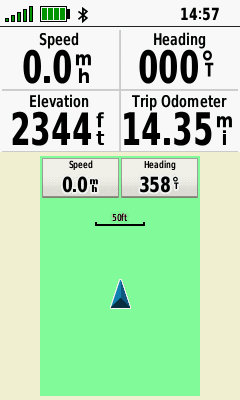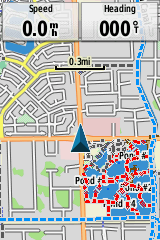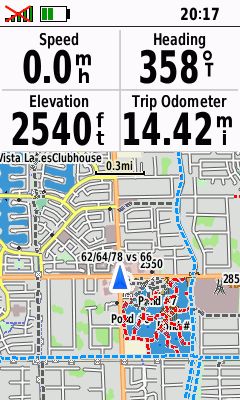Q. Does the Map page on the GPSMAP 62/64/78
series with only two date fields enabled provide more usable map viewing space
than the newer GPSMAP 66 with four data fields displayed?
A. No. Not even close. Here's why:
By the Numbers
- The GPSMAP 62/64/78 series full Map page resolution is 160 x 240 (38,400 pixels).
- The GPSMAP 66 series full Map page resolution is 240 x 376 (90,240 pixels), a 135% increase over the GPSMAP 62/64/78.
- With two data fields visible on a GPSMAP 62/64/78, the Map page resolution is reduced to 160 x 196 (31,360 pixels).
- With four data fields visible on a GPSMAP 66, the Map page resolution is reduced to 240 x 248 (59,520 pixels), a 89% increase over the GPSMAP 62/64/78.
- GPSMAP 62/64/78 Map page transposed over a GPSMAP 66 Map page for comparison:

Scale and Resolution
- Map data such as waypoints and POIs are always displayed on the Map page at a fixed size, giving the GPSMAP 66 a clear advantage.
- All remaining map information is scaled based on the selected Map page zoom level.
- Notice when a GPSMAP 62/64/78 Map page is transposed over a GPSMAP 66 Map page, both scales use the same number of pixels:

The Grand Illusion
- The GPSMAP 62/64/78 series use a 2.6" (1.43" x 2.15") display at 110 ppi.
- The GPSMAP 66 series are equipped with a 3.0" (1.5" x 2.5") display at 155 ppi.
- When rendering the Map page, the GPSr does not care about the actual physical dimensions of the screen, it only cares about pixel count.
- While a GPSMAP 62/64/78 Map page with two data fields enabled allows more of the screen to display map data compared to a GPSMAP 66 with four data fields enabled, the GPSMAP 66 Map page still shows 89% more map information than a GPSMAP 62/64/78:
 |
 |
|
|---|---|---|
| GPSMAP 64 Map Page | vs. | GPSMAP 66 Map Page |
| Both GPSr are centered on the same intersection with identical map and map zoom settings | ||